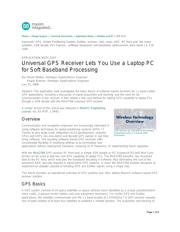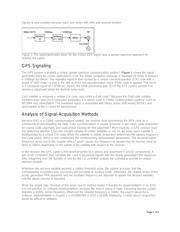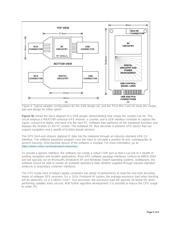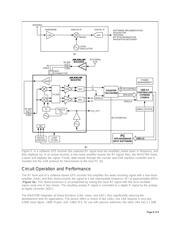herunterladen

Click here for an overview of the wireless
components used in a typical radio
transceiver.
Maxim > Design Support > Technical Documents > Application Notes > Wireless and RF > APP 4237
Keywords: GPS, Global Positioning System, Galileo, receiver, LNA, mixer, ADC, RF front end, low noise
amplifier, USB dongle, PCI Express , software baseband, soft baseband, downconvert, base band, L1, C/A
code,
APPLICATION NOTE 4237
Universal GPS Receiver Lets You Use a Laptop PC
for Soft Baseband Processing
By: David Weber, Strategic Applications Engineer
Roger Bremer, Strategic Applications Engineer
Jun 11, 2008
Abstract:
This application
note investigates the basic theory of software-based receivers for L1-band civilian
GPS applications, including a discussion of signal acquisition and tracking, and the need for bit
synchronization in the receiver. It then details a low-cost method for adding GPS capability to laptop PCs
through a USB dongle with the MAX2769 universal GPS receiver.
A similar version of this article was featured in Maxim's Engineering
Journal, vol. 63 (PDF, 1.3MB).
Overview
Communication and navigation engineers are increasingly interested in
using software techniques for global positioning systems (GPS).
1,2
Thanks to very-large-scale integration (VLSI) development, powerful
CPUs and DSPs can now detect and decode GPS signals in real time
using software. The resulting software-based GPS receivers offer
considerable flexibility in modifying settings to accommodate new
applications without redesigning hardware, choosing an IF frequency, or implementing future upgrades.
With the MAX2769 GPS receiver RF front-end, a simple USB dongle or PCI Express® (PCIe®) Mini Card
format can be used to add low-cost GPS capability to laptop PCs. The MAX2769 transfers raw recovered
data to the PC host, which executes the baseband decoding in software, thus eliminating the cost of the
baseband ASIC typically required in stand-alone GPS systems. In short, the MAX2769 enables designers to
implement an adapter capable of handling GPS and Galileo signals using a single chip.
This article provides an operational overview of GPS systems and, then, details Maxim's software-based GPS
receiver solution.
GPS Basics
A GPS system consists of 24 space satellites or space vehicles (each identified by a unique pseudorandom-
noise code), a ground-control station, and user equipment (receivers). For civilian GPS and Galileo
applications, the satellites communicate over the L1 band located at 1.57542GHz.
3
A GPS receiver requires
line-of-sight visibility of at least four satellites to establish a reliable position. The acquisition and tracking of
Page 1 of 8








